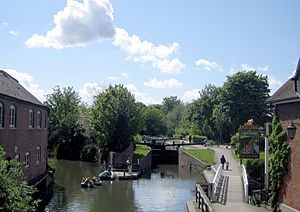Newbury Lock facts for kids
Newbury Lock is a special kind of water gate on the Kennet and Avon Canal. You can find it right in the middle of Newbury, a town in English county of Berkshire. This lock helps boats move between different water levels on the canal. It can raise or lower boats by about 3 feet 6 inches (1.07 meters). It's located just a short distance upstream from Newbury Bridge.
Contents
Newbury Lock: A Historic Watery Elevator
Newbury Lock is a lock that works like a watery elevator for boats. It helps them travel along the Kennet and Avon Canal. When a boat wants to go up or down, it enters the lock chamber. Then, the water level inside the lock is either raised or lowered to match the next section of the canal. This allows boats to continue their journey smoothly.
Built a Long Time Ago
This lock is very old! It was built in 1796. That's over 200 years ago! It was part of building the Kennet and Avon Canal, which connects Newbury and Bath. A famous engineer named John Rennie helped build the canal.
The lock itself is considered a special old building. It has strong brick walls topped with Bath Stone. The walls are wider at the top to help protect them from damage caused by frost and ice in cold weather.
Connecting Rivers and Cities
Newbury Lock was once the very first lock on the Kennet and Avon Canal if you were traveling from the east. Downstream from the lock, the canal connected to an even older waterway called the Kennet Navigation. This older part was opened in 1727 and went between Reading and Newbury.
The whole Kennet and Avon Canal opened completely in 1810. This created a full water route between London and Bristol. It connected the River Thames, the Kennet Navigation, and the River Avon. In 1812, the Kennet and Avon Canal Company bought the Kennet Navigation. Now, most people think of the Kennet Navigation as part of the larger Kennet and Avon Canal.
The Ebb And Flow Sculpture
Right next to Newbury Lock, you can see a cool piece of art called Ebb And Flow. It was made by a sculptor named Peter Randall-Page. The artwork has a large granite bowl in the middle of a spiral path, also made of granite. This path leads down from the lock.
What's really neat is how it works: the bowl is connected to the lock by pipes hidden underground. So, when the lock fills up with water, some of that water flows into the bowl. Then, as the water level in the lock goes down, the water in the bowl also empties out. It shows how water constantly moves, just like the tides!



